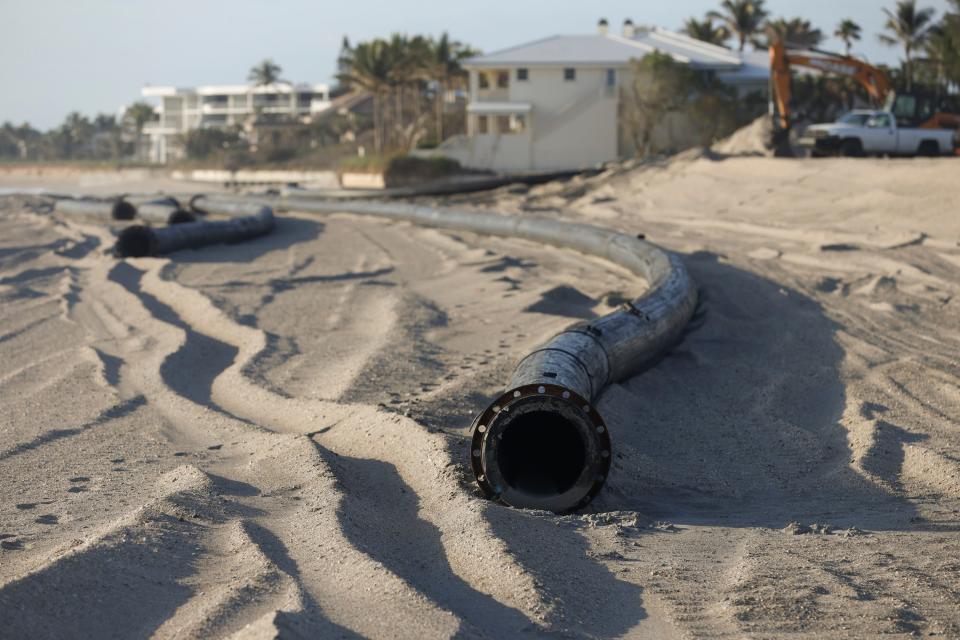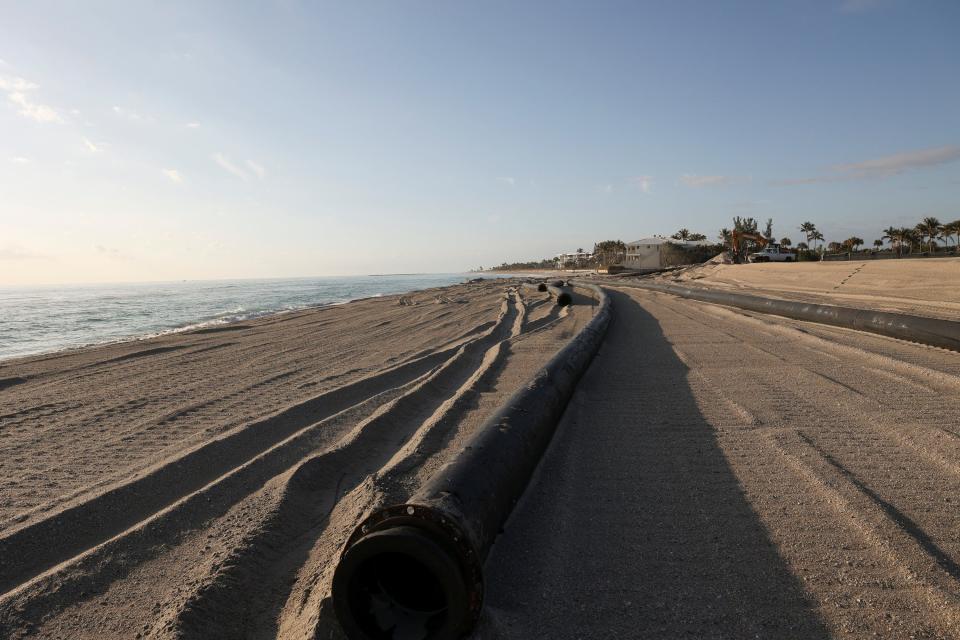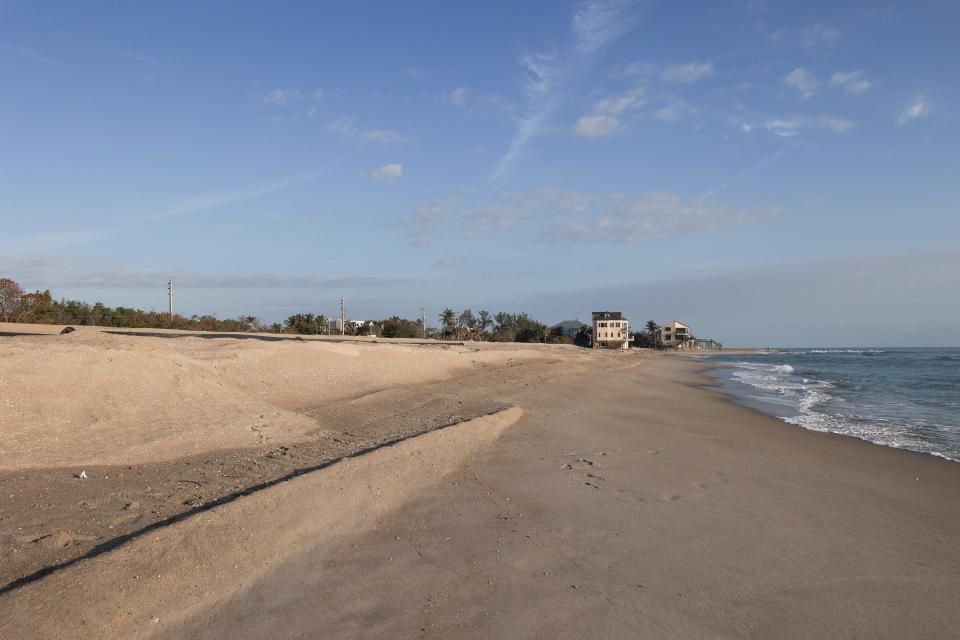Millions spent each year repairing beaches, only to have storms, erosion hit them again
Pummeling the Treasure Coast over the years, wind-blown waves from hurricanes and tropical storms continually erode the sandy source of tourism dollars: the local beaches.
Erosion is a factor nearly every year, so it seems like counties face a never-ending cycle of beach renourishment. Why, then, do counties keep repairing them?
"Tourism is the bread-and-butter of the Treasure Coast," explained Joshua Revord, director of port, inlet and beaches for St. Lucie County. "Our livelihoods depend on it."
Tourists spent $693.2 million in St. Lucie County in 2022, according to the most recent numbers from Visit Florida, the state tourism agency. And beaches are the No. 1 one reason people visit, according to a 2023 visitor tracking study by Visit St. Lucie, the county's tourism organization.
"Travel and tourism is America’s largest employer and earner of foreign exchange, and beaches are its leading tourist destination," James Houston of the U.S. Army Engineer Research and Development Center in Vicksburg, Mississippi, wrote in a 2018 paper published in Shore & Beach.
At that time, beach tourism nationwide supported 2.5 million jobs, generates $45 billion each year in taxes "and returns $230 in federal taxes for every $1 the federal government spends on beach nourishment," Houston wrote.
"We see our beachside area brings in the most tourism to our county," said Ben Earman, vice president of tourism and marketing for Indian River County.
In Martin County, beaches stand out as "one of the many vital pillars of our local tourism sector, alongside our vibrant arts-and-cultural sector, our diverse attractions, local shopping and dining experiences,” said Tourism Director Nerissa Okiye.
Beach renourishment simplified
But what is beach renourishment and how is it accomplished? Revord simplified it.
"Beach projects are often planned when chronic erosion has been historically documented and there is a high likelihood of negative impacts to property and/or adjacent infrastructure," Revord said.
Construction starts with acquiring federal and state permits. Permits require counties monitor how well the work holds up and impacts to plants and wildlife. St. Lucie County, for example, must survey beach slopes and monitor sea turtle nests, shorebird nests and reefs every year for three years following restoration, Revord said.

How it works
Sand is taken from either a land-based mine or from the ocean floor. Whatever the source, it can't be just any sand. It must have technical and granular characteristics similar to the beach where it's going. Investigations are done beforehand to ensure that.
Investigations involve sampling the sand in mines or taking borings from the ocean floor. Workers also determine the depth and width of sand available if it's taken from the ocean.
St. Lucie County has used Capron Shoal and St. Lucie Shoal as ocean sources of sand for the Fort Pierce Shore Protection Project and the South County Beach Project, respectively. Dredging typically is done by a contractor.
A dredge sucks sand from the ocean floor, places it in a hopper and later adds fluid before pumping it onto the beach. Bulldozers manage the sand/fluid mix using it to form a berm.
Workers may screen the pumped sand to reduce the amount of shells and rocks in it.

Costs and funding
Beach erosion has cost Treasure Coast governments more than $100 million over the last five years to restore the sand. Local counties usually go after state and federal funding to offset the cost of restoration projects.
"St. Lucie County maintains longstanding relationships with the Florida Department of Environmental Protection and the U.S. Army Corps of Engineers, both of which contribute financially to our projects," Revord said.
The state offers competitive grants for renourishment projects. Federal funding follows from congressional approval of Army Corps feasibility studies. Public access to the beach is the most important criteria considered in requests for funding.

A typical restoration project in St. Lucie County costs $10 million to $12 million, Revord said. Of that, the county typically pays 15%.
A Martin County restoration project underway at popular Bathtub Beach is expected to cost $7.1 million, county spokeswoman Martha Ann Kneiss said. The county is sharing the cost with federal and state agencies and the Sailfish Point Property Owners Association, kicking in $1.7 million.
More: Beaches expected to take a hit again from two-day storm that pounded Treasure Coast
More: Storm knocks out power to some in St. Lucie, sets up 'nasty' weekend at area beaches
In Indian River County, more than $28 million has been spent on beach restoration over the past five years, county Budget Director Kristin Daniels said. But that's only the cost of construction, and excludes monitoring and design, among other work.
Construction is expected to cost $73.5 million in St. Lucie County for projects that began in 2020 up to the present, including two pending projects that will ramp up in October. St. Lucie County's share is $7.1 million. In Martin County, the total cost of restoration over the last five years is expected to reach $16.9 million; the county's share will be $5.8 million.
Keith Burbank is TCPalm's watchdog reporter covering Martin County. He can be reached at keith.burbank@tcpalm.com and 720-288-6882.
This article originally appeared on Treasure Coast Newspapers: Treasure Coast beach restoration: What it costs and how it works

